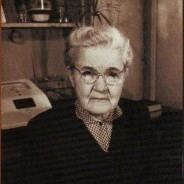Nationality Latvian Occupation chemist | Other names Lidiya Karlovna Lepin\' Name Lidija Liepina | |
Known for helped create the first Russian gas mask | ||
Lidija Liepiņa ([ˈli.di.ja ˈli͡ɛ.pi.ɲa], Russian: Лидия Карловна Лепинь; 4 April 1891 – 4 September 1985) was a Latvian chemist, and one of the first women to receive a doctorate in chemistry in Russia. Known for her research in colloidal chemistry. She lived in Russia until after World War II and then moved to Latvia for the remainder of her life. As a student, she helped create the first Russian gas mask and later published her theories about gas adsorption. She received many awards for her research contributions including induction into the Latvian Socialist Soviet Republic Academy of Sciences, the Medal For Valiant Labor in the Great Patriotic War, Order of the Red Banner of Labor, Hero of Socialist Labor, the Order of Lenin and the "Hammer and Sickle" gold medal.
Contents

Liepiņa's research interests were diverse, encompassing several different areas of physical chemistry and colloidal chemistry. She investigated colloids' effects on corrosion, absorption in solids, dispersion, formation of hydrides, and surface reactions.
Biography
Liepiņa was born on 4 April (March 22 O.S.) 1891, in Saint Petersburg, Russia to a Latvian father, Kārlis Liepiņš, and a Russian mother, Ekaterina A. Shelkovskaya. Her father, who was a forester, worked on the estate of Prince Golitsyn and she was raised in both Russia and Latvia. She attended a private girls' school and then graduated from the L.F. Rzhevskoy Women's Gymnasium in 1908, earning a gold medal for her academic excellence. Because women were forbidden to enter university, Liepiņa was required to take private classes to be certified as a home tutor. She completed her studies in 1909 and was certified to tutor language arts, mathematics and both French and Russian languages. With this certificate, she was allowed to continue her studies, if her father gave permission, but she was torn between chemistry and music. Her father granted her permission to study both at the natural history department of the Moscow Higher Courses for Women and to enroll in the Moscow Conservatory of Music. For a few years, she studied both before finally choosing chemistry over music, though she was a skilled pianist.
In 1914, she suspended her studies and worked in the mobile chemical laboratory of Professor Nicholas Alexandrovich Shilov at the Western Front. The laboratory was in a train boxcar and the task of the team was to test and create a quality gas mask. They tested the masks using various materials including coal gas, chlorine gas, phosgene and various filters which included charcoal and even tobacco. The scientists were credited with creating the first Russian gas mask, though poor-quality prototypes existed before their work. She would later publish her notes on their works around 1919 which she called the "theory of dynamic adsorption". She returned to school in 1915 and finished her studies in September 1917. Two months later, she took a qualifying examination to allow her to teach and after successfully passing it, began teaching analytical and inorganic chemistry at the National Commercial Institute (NCI). In 1920, Liepiņa also started teaching at the Moscow Higher Technical School as the school's first woman teacher. During this time, she was conducting research with Shilov and published influential papers on electrode potentials and also on the regularity of surface adhesions of gases. Throughout the 1920s, she made several trips to Germany to study in labs there with Nobel Prize winner Fritz Haber, Max Bodenstein, Wolfgang Ostwald and others. In 1930, she left her position with the NCI but continued to teach and research at the Technical School. Liepiņa joined the new Military Academy for Chemical Protection in 1932, where she became head of the colloid chemistry department. In 1934, she was made a full professor, the first woman to be awarded a professorship and in 1937, she was awarded a doctorate from the Presidium of the Supreme Soviet, one of the first in the country awarded in chemistry to a woman.
In 1941, Liepiņa left the Chemical Academy and went to work at the University of Moscow. Though it was officially evacuated in the summer of 1941 due to World War II, classes were still held and those who had not left were expected to work in the unheated buildings. Liepiņa remained in Moscow and served as Head of General Chemistry until 1943, for which she was later awarded the Medal For Valiant Labor in the Great Patriotic War. In 1946 she moved to Riga accepting the position of professor in the department of physical chemistry at the University of Latvia. By the early 1950s, she had published over 60 scientific papers and in 1951 she was elected as an academician of the Latvian Socialist Soviet Republic Academy of Sciences. She remained at the University of Latvia until 1958, when a Chair was created for her in physical chemistry at the Riga Polytechnic Institute. In 1960, Liepiņa was awarded the Order of the Red Banner of Labor and then in 1962, she was honored by the Supreme Council of the Latvian Socialist Soviet Republic. In 1965, she was granted the title Hero of Socialist Labor, the Order of Lenin and the "Hammer and Sickle" gold medal. By the end of her career, she had written, or co-written over 210 scientific papers and was awarded a special diploma in 1971 from the Ministry of Higher and Secondary Education.
Liepiņa died on 4 September 1985 in Riga, Latvia and was buried in the First Forest Cemetery of Riga after a state funeral which was attended by senior officers of the Soviet Armed Forces and scientists.
Selected works
Liepiņa published in both the USSR and in Latvia. Throughout the 1950s, she had many articles published in the Proceedings of the Latvian Academy of Sciences. Some of her works are:
